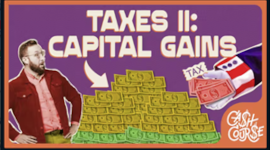The free Financial Literacy Cash Course teaches teens (as well as adults) selected aspects of economics from a free-market perspective via short videos and worksheets. The lively videos include both actors and animations, cramming a lot of information into only about five minutes per video. They are excellent!
Each video has a lesson plan, a worksheet, and an answer key. The lesson plans turn each video into a 45-minute group class, but students can watch the videos on their own and complete the provided worksheet, usually in ten or fifteen minutes.
The lesson plans list objectives, vocabulary, educational standards addressed, and resources needed for the lesson, followed by step-by-step instructions for teaching the interactive lesson. The worksheet and answer key for each video has five or six pairs of items in columns to match, four multiple-choice questions, and an application question. The application questions vary. For instance, one has students compute the exchange value of U.S. dollars for euros. Another has students find a product for which demand has changed over time and correlate changes in price in relation to demand. Yet another has students complete a chart showing which business form (e.g., sole proprietor, LLC, corporation) best fits four types of businesses and provide supporting reasons.
Most of the videos deal with personal (micro) economics. I’ll list them under two headings since students watching these as a course should usually begin with the macroeconomic topics to learn about the big picture first. The videos available as of April 2024 are:
Macroeconomics
- What is an Economy?
- What is Currency?
- Supply & Demand
- What are Commodities?
Microeconomics
- Accounting Basics 101
- Understanding Assets and Liabilities (personal finances)
- What is a Budget?
- Manage Your Financial Hygiene (budgeting and goal setting)
- Becoming a Business
- Retirement Savings Accounts
- The Basics of Inheritance
- Insurance Basics
- Auto Insurance
- Health Insurance
- Financial Institutions
- Checking and Savings Accounts
- What are Savings?
- Simple vs. Compound Interest
- Student Loans
- Borrowing
- Debt!
- Good vs. Bad Credit
- Credit & Debit Cards
- Renting vs. Owning
- How are You Getting Paid?
- Paystubs
- Understanding Taxes
- Know Your Tax Forms
- What is Investing?
- Stocks
- Investing & Bonds
- Cybercrimes and You
- Crypto Currency
Students don’t need to watch all the videos. Some might be more appropriate at a different stage of life and can be skipped for now.
Because the Financial Literacy videos are weighted toward microeconomics, it makes sense to combine them with one or more additional resources if you want to create a complete economics course. For example, these videos complement R.C. Sproul Jr.’s Economics for Everybody: Applying Biblical Principles to Work, Wealth, & the World (Compass Classroom). Both resources come from a free-market viewpoint: Sproul teaches macroeconomics from a Christian worldview, while the Financial Literacy videos cover personal economic decision-making from a secular point of view. Examples of secular resources that might complement the Financial Literacy videos are Economics 101: The Principles of Free Market Economics (free video course from Hillsdale College) and Simply Put: A Study in Economics by Catherine Jaime.
Summary
The Financial Literacy Cash Course is a fantastic, free resource for homeschoolers who prefer a free-market approach.









